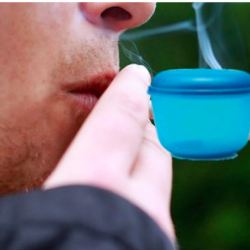It is difficult to blame Americans for being unable to determine what constitutes a real risk and a theoretical one. Or serious risk from a trivial one. The "Organic/Natural" movement has done a magnificent job of seeding American minds with just enough partial or incorrect information that it is all but impossible for non-scientists to separate the organic wheat from the organic chaff. The result: massive confusion, reliance on celebrities and quacks, and the persistence of a ubiquitous but ill-defined unease about things that sound scary.
But fear sells, and if there is one collective mindset among Americans and their health fears, it is surely chemicals and cancer. As the Whole Foods' of the world continue to reinforce the myth that chemicals must be avoided, the public is all but guaranteed to make poor choices based on false premises. These choices, when taken together, result in a perverse "risk inversion" - small risks are magnified and real ones ignored.
Central to the "risk inversion" is the false belief that we can prevent disease, especially cancer, by getting chemicals out of our lives. But ironically, these false beliefs directly contradict what is known about bona fide ways to prevent cancer, and can even promote the cancers that could otherwise be prevented. Here are three examples.
1. Sun vs. Sunscreen
The unfailingly wrong Environmental Working Group (EWG) has a Skin Deep® program in which rates 80,000 personal care products and a similar Guide to Sunscreens. The thrust of both programs is the same - that products that people use on their skin are often harmful, even though this is almost universally false (1). The harm from this misinformation becomes immediately obvious from a quick visit to the organization's certifiably insane "Sunscreen 101" page.

From the EWG website. It's EWG that should really be your last resort.
Yet the above "tip" is right there for all to see, which is rather alarming considering the significant rises in malignant melanoma over the past 35 years.
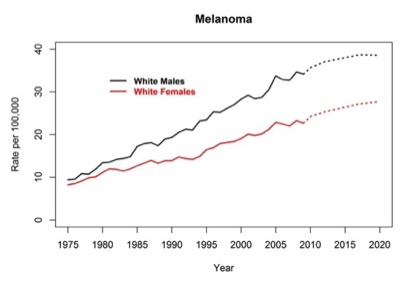
The incidence of malignant melanoma in the US by year. Source: CDC
And the harm from sunscreen? The usual - endocrine disrupting chemicals, for example, oxybenzone, a common sunscreen ingredient, which has been in use for almost 40 years. The EWG, as usual, relies upon terrible science to make its point (emphasis mine).
In a recent evaluation of CDC-collected exposure data for American children, researchers found that adolescent boys with higher oxybenzone measurements had significantly lower total testosterone levels (Scinicariello 2016). The study did not find a similar effect in younger boys or females. The researchers cautioned that their results are a single-day snapshot instead of a controlled study of the effect of multi-day exposures.
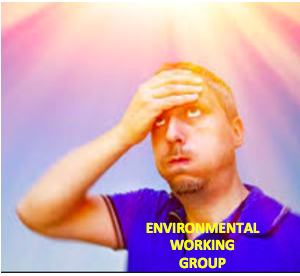
EWG - Out in the sun too long. As always. Photo: Vita4you
This is quintessential EGW - making a bold, scary claim based on an experiment that means nothing. A study consisting of a single snapshot with an effect of unstated magnitude in a select population group is worthless. Does that stop them from using it anyhow? No. It never does.
WHICH CHOICE RESULTS IN HARM?
It is not difficult to see how a certain number of (especially) parents and others will be afraid of the chemicals in sunscreen and elect not to use it, despite the fact that the harm from the sunscreen, if any, is not only unproven but most likely wrong. The sun is known to cause skin cancers. Sunscreen ingredients, many of which have been used for decades, carry, at most, a theoretical risk, which, based upon analogous studies of other chemicals, will almost certainly be shown to be inconsequential or nonexistent.
This is a perfect example of how third-rate science can overrule known facts by using nothing more than suggestions of harm. The take-home message - fear the sunscreen more than the sun. Quintessential junk science.
2. Marijuana vs. Plastics
Aside from a handful of desperate academics, those using evidence-based science has concluded that the tiny amount of the plastic component bisphenol A (BPA), which has been in use for 60 years, poses no threat to humans. The FDA's comprehensive CLARITY-BPA study concluded that during a two-year study of rats (the typical lifespan of a rat) there were no significant findings of any kind. The conclusion:
“BPA produced minimal effects that were distinguishable from background in this study.”
Since BPA is one of the most studied chemicals on earth, there are many knocks against it, but the primary "concern" is the usual - that the chemical acts like estrogen, thus creating a host of physiological effects. The same old "endocrine disruptor" argument (1). BPA has also been blamed for breast cancer.
On the other hand, marijuana has been given a "free pass." Except there's one problem - the chemicals in marijuana are far better estrogen mimics than BPA and you are getting far more of them, something that a monograph published by National Institute on Drug Abuse makes clear:
- "a clear demonstration of the inhibitory effect of THC on suckling-induced prolactin secretion..."
- "...protein and nucleic acid synthesis, glucose utilization steroidogenesis have shown that these drugs disrupt gonadal cannabinoids"Other in vitro studies with and prostaglandin synthesis, and reduce cyclic AMP concentrations in various species."
A paper entitled "Endocrine effects of marijuana in the male: preclinical studies" published in the National Institute on Drug Abuse Research Monographs adds the following:
- "'Endocrine effects of marijuana in the male: preclinical studies.'Marijuana affects a variety of hormones that are regulated by hypothalamic function and it appears that the psychoactive ingredient, THC, is the major compound responsible for this action."
- "The two gonadotropins, LH and FSH, secreted by the pituitary gland are of major importance to reproduction in the male..."
- "The THC-induced block of GnRH release results in lowered LH and FSH which is responsible for reduced testosterone production..."
MARIJUANA IS LOADED WITH ENDOCRINE-DISRUPTING CHEMICALS. WHAT SHOULD YOU DO?
So, if you're terrified of the endocrine-disrupting chemicals in the plastic container that holds your marijuana, you may be better off smoking the container (2).
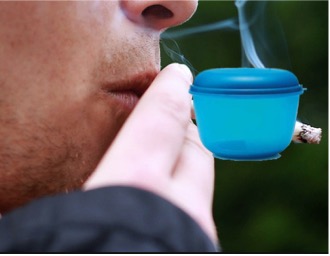
Protect your endocrines. Smoke Tupperware! Original photo: CBS News
3. Wine vs. Diet Coke
Even my most educated friends glare at me when I order something with an artificial sweetener. Roughly 100% of the time the response is the same - "that's just a bunch of chemicals." They are correct. It is just that. But so is the Chardonnay they are drinking. Which drink has the most carcinogenic "bunch of chemicals?" It's the wine, and by a lot (3). Wine contains ethanol, which is a Group 1 carcinogen (IARC classification) - "carcinogenic in humans." Epidemiological studies, which may or may not be accurate, show that alcohol consumption is linked to an increase in breast cancer (4).
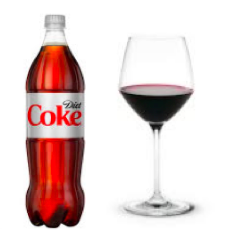
Eeny, meeny, miny, moe. Photo: Holme Gaard
"Wait," you say. "Aspartame contains methanol, which is converted to formaldehyde, a known carcinogen. This is also true but in a cancer competition between wine and Diet Coke, wine "wins," hands down for two primary reasons:
- Exposure. A Diet Coke, upon digestion, will produce about 10 mg of formaldehyde (See Sorry, Your Diet Coke Is Not Calorie-Free). A 5-ounce glass of wine contains 14 grams of ethanol, which will be converted to about 14 grams of acetaldehyde - also a Group 1 carcinogen. So, the wine will expose you to 1,400 times more carcinogen than the soda. (Which drink is really a bunch of chemicals?)
- Metabolic outcome. Both formaldehyde and acetaldehyde are rapidly converted (half-life of 1.5 minutes) to harmless metabolites, which automatically limits the body's exposure to the chemicals. But formaldehyde has an addition biochemical pathway in the body; it is essential for the endogenous biosynthesis of DNA nucleotides. Formaldehyde is essential for every cell in your body. The body makes, uses, and disposes of 50 grams of formaldehyde daily in a process called the one-carbon pathway (See Formaldehyde Is So Dangerous That You'd Be Dead Without It). There is no comparable use for acetaldehyde. It is merely a poison that is detoxified.
BOTTOM LINE
There are certain known ways of preventing certain cancers, for example, sun protection, diet, colonoscopies, not smoking, getting vaccinated against HPV and hepatitis B... others. Even so, your best protection is... luck. A 2017 article in Scientific American claims that two-thirds of all cancers result from genetic mutations that happen during faulty cell division, in other words, bad luck (5).

But the following are clear.
- The sun is far more dangerous than sunscreen.
- Marijuana has a far greater impact on your hormones than plastic.
- And there is much more of a carcinogen in a glass of wine than in a diet soda.
Does this mean that you need to stay in the dark, never try a joint or drink alcohol? Of course not. But sun, marijuana, and alcohol are real risks, even if they are relatively small. But sunscreen, Tupperware, and diet soda pose little or no risk, even though they are constantly portrayed as otherwise.
Each of these examples involves lifestyle choices - going outside with or without sunscreen, using marijuana or plastic containers, or having a diet soda or a drink. You get to choose which of these potential risks are acceptable and weigh them against your quality of life. The odds that a glass of wine with dinner, a joint, or a trip to the beach will give you cancer are real but low. If these don't concern you, go ahead. Chances are you'll be fine. Just don't worry about the false scares - sunscreen, plastic containers, or artificial sweeteners. Their risks are either theoretical or close to nil.
It's all about relative risk and perception. And fear.
NOTES:
(1) BPA does bind to estrogen receptors but does so 10-12 thousand times more weakly than estradiol. (See Put Vox In The Litter Box - Same Old Plastic Scares.)
(2) Marijuana smoke contains some of the same carcinogens as cigarette smoke.
(3) I am not saying that a glass of wine (or even a whole lot of glasses) will give you cancer, but it is indisputable that alcohol is carcinogenic. Even though I have little use for either IARC's list of 895 potential or known carcinogens or (even less) California's deranged Proposition 65 list, both lists classify ethanol as a known human carcinogen, and neither lists aspartame.
(4) I regularly critique epidemiological studies because they are mostly junk. I have no idea of the quality of the studies of alcohol and breast cancer. I'm just putting it out there.
(5) The authors stress that this doesn't mean that only 33% percent of cancers are preventable. Another study puts this number at about 40%.
